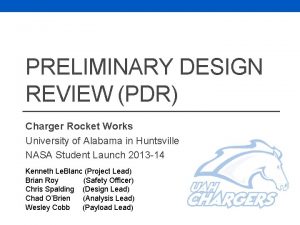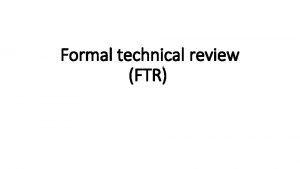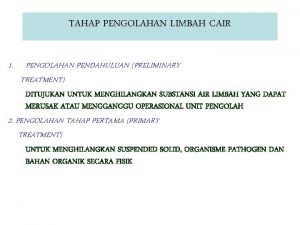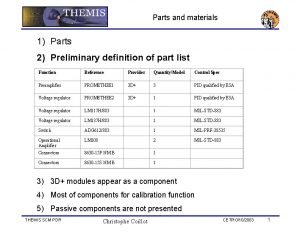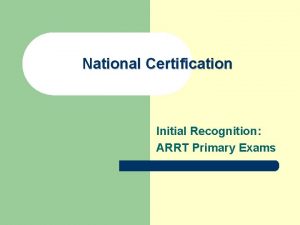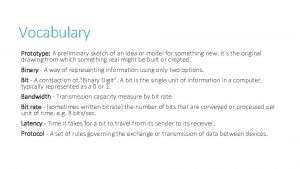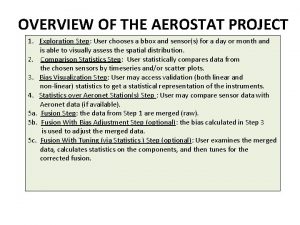Western Aerostat Fliers Preliminary Design Review Western Technical

















































- Slides: 49

Western Aerostat Fliers Preliminary Design Review Western Technical College LSI’s: Jon Grotjahn, Travis Haugstad, Joel Nielsen Mentor: Dr. Mike Le. Docq 3/21/2015 Tethered Aerostat Program Preliminary Design Review

Mission Overview Jon Grotjahn and Joel Nielsen Tethered Aerostat Program Preliminary Design Review

Mission Statement: Our goal is to safely and reliably fly an aerostat and payload package to test and discover the application and limitations of Ka band power beaming technology. Tethered Aerostat Program Preliminary Design Review

Mission Overview • Prove effectiveness of Ka band power beaming over a variety of distances • Use to beam power to and from balloon • Immediately benefits NASA as a way to provide power to satellites • Eventually may benefit mankind as alternative energy distribution Tethered Aerostat Program Preliminary Design Review

Mission Overview: Mission Objectives • Prove concept of Ka band power beaming • • • Repeatable power transmission at variety of altitudes Power instrument package indefinitely Beam harvested power from aerostat to ground • Determine efficiency over distance, time, and with varying atmospheric conditions • • Develop range of conditions where consistent measurable results can be achieved Understand limitations due to varying conditions Tethered Aerostat Program Preliminary Design Review

Mission Overview: Minimum Success Criteria • Verify power transmission • Determine distance limitations of power beam • Power instrument payload Tethered Aerostat Program Preliminary Design Review

Mission Overview: Theory and Concepts Radar Frequency Bands 24. 05 -24. 5 GHz X-band 10. 5 -10. 55 GHz K-band Ka Band 33. 4 -36. 0 GHz • Ka band covers 33. 4 -36. 0 GHz • Primarily used in vehicle speed detection and satellite communication • XISP developing “beaming” power to small Cube. Sat from ISS Tethered Aerostat Program Preliminary Design Review

Mission Overview: Aerostat Concept of Operations Ka Radar Antenna AIM XTRA Variable DC Power Supply Logging Laptop Base Unit Generator 0 V Ground 30 V + - Ka Beaming Radar

Mission Overview: Concept of Operations At 152. 4 m (500 ft) Every 15. 3 m (50 ft) Pre-launch 1) Ka band power transmission test 2) Switch to backup power 3) Collect data from all instruments 4) Hold altitude and run power efficiency tests 1) Ka band power transmission test 2) Switch to backup power 3) Collect data from all instruments 1) Safety check 2) Arm payload 3) Instrument and communication test

Mission Overview: Expected Results • Ka band power beaming successful, but ability to beam power could be lost between 15. 3 m and 152. 4 m • Switching to backup power will be successful • Successful collection of data from instrument payload • Weather conditions likely to influence results Tethered Aerostat Program Preliminary Design Review

System Overview Travis Haugstad Tethered Aerostat Program Preliminary Design Review

System Level Block Diagram Tethered Aerostat Program Preliminary Design Review

System Design – Physical Model Tethered Aerostat Program Preliminary Design Review

System Design – Physical Model Tethered Aerostat Program Preliminary Design Review

System Concept of Operations • Radar emitter • • • Antenna Array • • Sensor circuitry produces 3 V signal when radar is detected 3 V signal sent to AIM XTRA for transmission to logging computer Kestrel Weather Station • • • Converts Ka radar signal to voltage Voltage processed by receiver and sent to “dummy” load Voltage meter sends reading to AIM XTRA for transmission to logging computer Radar Detector • • • Sends Ka radar signal to aerostat Radar detector on ground sends signal to laptop Self contained power supply Self contained data logging AIM XTRA • • Receives power from on-board power supply Receives data inputs from radar detector, radar antenna, solar energy sensor, and electrical power supply Tethered Aerostat Program Preliminary Design Review

Critical Interfaces Interface Name Brief Description Ka transmitter/Antenna The theory of Ka power beaming has been tested and demonstrated. At this point, we do not have the already developed equipment secured. Extensive testing of Ka radar guns and antennas may be necessary to develop our own power beam. The electrical power supply (EPS) must supply the AIM XTRA (AX) and Arduino with 7. 4 volts. Two pairs of 3. 7 V Lithium Ion batteries in a series aiding configuration. One will be charged while the other is powering the system. We will use the Arduino to control the charging. We must detect if the payload is receiving Ka band signal using radar sensor from Cobra SPX 5500. We will use the electrical power system’s Arduino to pick up and analyze the data before being sent to the AIM XTRA. The AIM XTRA will need to mount rigidly to the payload deck and will also need to be weather resistant to protect sensitive electrical components. Electric wrap or 3 D printed case. Light intensity will need to be measured to further understand correlations to UV intensity and it’s effect on Ka band power beaming. General Tools DBTU 1300 digital solar power meter provides digital output of light intensity used for measuring solar energy. Output could be sent directly to AIM XTRA for data transmission. EPS/AX Radar detection/EPS AX/Payload Deck Light intensity detector/AX Tethered Aerostat Program Preliminary Design Review Potential Solution

Requirement Verification Table: Ka radar Requirement Verification Method The Ka power beam must deliver 1 watt of power at a minimum distance of 15. 3 m Demonstration The beamed power must remain stable while power is dissipated through dummy load Analysis The optimum rectenna will be mounted to the payload deck Inspection Mock builds will verify this requirement Test The system will be subjected to multiple test flights The system shall be able to reproduce power transfer results with same test conditions Description Power analysis will be conducted on the ground in a controlled environment The power dissipated will be monitored by a current sensor connected to the dummy load and data sent to AIM XTRA for real time data logging Tethered Aerostat Program Preliminary Design Review

Requirement Verification Table: EPS Requirement Description Verification Method The EPS will supply the components will adequate power. Demonstration The power supply design does not overload the payload with volts and current. Analysis The full system shall fit on a single Aerostat payload deck and keep the weight to a minimum. Inspection The electrical power system will maintain power indefinitely with the help of a solar panel. Test A power on test where everything is running well. A system analysis with a volt ammeter. Visual inspection and scale will verify this requirement. The system will be subjected to a full power test for one day prior to launch. Tethered Aerostat Program Preliminary Design Review

Requirement Verification Table: FDC Waiting for table from Jon similar to previous slides Tethered Aerostat Program Preliminary Design Review

Subsystem Design Ground System Jon Grotjahn and Joel Nielsen Tethered Aerostat Program Preliminary Design Review

Design Overview: Engineering Design • Ground Equipment • Radar gun and amplifier to produce Ka band radar waves to beam power to aerostat • Radar detector and LED indicator to ensure radar waves are emitted • Base station will receive data from AIM XTRA • Laptop will log all data from base station • Radar gun and detector will be powered by DC power supply • Laptop will be powered by AC generator • Base unit receives power via USB cable from Laptop Tethered Aerostat Program Preliminary Design Review

GND: Risk Matrix GND. RSK. 2 GND. RSK. 1 Consequence GND. RSK. 3 Possibility GND. RSK. 1: Mission objectives aren’t met IF Ka power beam is not acquired or developed GND. RSK. 2: Mission objectives aren’t met IF real time data logging is unsuccessful GND. RSK. 3: Mission timeline delayed if Ka power beam is not supplied by XISP Tethered Aerostat Program Preliminary Design Review

Subsystem Design Electrical Power System Travis Haugstad Tethered Aerostat Program Preliminary Design Review

Electrical Power System: Block Diagram Tethered Aerostat Program Preliminary Design Review

EPS: Components • • • Four 3. 7 volt Lithium Ion batteries • Two packs with 3. 7 volts batteries wired in series for 7. 4 volts 6 volt, 5. 6 watt Solar Panel Arduino Uno D/C lithium charging control unit Optocouplers Tethered Aerostat Program Preliminary Design Review

EPS: Solar Panel • 6 V, 5. 6 W solar panel delivers required current for electrical system • Charging of two 3. 7 V battery packages demands higher current • Solar panel is weatherproof providing protection against water infiltration which could damage panels and other circuitry Tethered Aerostat Program Preliminary Design Review

EPS: Charge Controllers • Converts power from solar panel to useable power to charge the lithium ion batteries • Necessary to safely and accurately control charging of lithium ion batteries • Dangerous when incorrectly charged Tethered Aerostat Program Preliminary Design Review

EPS: Lithium Ion Batteries • Lithium ion provides resistance to battery “memory” which causes degradation in performance over time • Switching between 2 battery packs for optimum power delivery does not allow battery to fully discharge • Very high power to weight ratio to reduce payload weight Tethered Aerostat Program Preliminary Design Review

EPS: Arduino and Optocouplers • Arduino controls charging and discharging of batteries • Arduino provides data measurements for system power • Optocouplers isolate Arduino and AIM XTRA from charging current • Removes noise from charging current for electrically sensitive devices • Protects Arduino and AIM XTRA from excessive current flow in the event of a fault in electrical system Tethered Aerostat Program Preliminary Design Review

EPS: Risk Matrix EPS. RSK. 1 EPS. RSK. 3 Consequence EPS. RSK. 2 Possibility EPS. RSK. 1: EPS will fail if a suitable charger cannot be obtained. EPS. RSK. 2: Information loss if we do not have the correct electrical components. EPS. RSK. 3: If EPS cannot support indefinite power, information will not be able to be transmitted. Tethered Aerostat Program Preliminary Design Review

Subsystem Design Ka Band Power Beam and Receiver Joel Nielsen Tethered Aerostat Program Preliminary Design Review

Power Beam Generation Block Diagram Ka Power Beam Generation Generator Champion 3500 W Aerostat Antenna Interface Inverter AC/DC Variable Power Supply Radar Gun Stalker ATR Ka Band Amplifier High Frequency Microwave Amplifier Laptop Data Logging Source Radar Detection Sensor • Ground Power Beam Generation • Generator produces AC power • AC to variable DC power supply which powers radar gun • Radar signal detected at source and data logged • Radar signal increased by microwave amplifier • Antenna system on aerostat receives power beam Tethered Aerostat Program Preliminary Design Review

Radar Detection Block Diagram • Radar Detection on Aerostat Ground Interface Electrical Power System Radar Detection Radar Detector Sensor From Cobra SPX 5500 Amplifier Op-Amp JFET Amp AIM XTRA Transmits data to Base station Voltage Regulator 3 V Zener Diode Voltage Regulator IC • Radar receiver removed from vehicle radar detector • Radar detector and digital circuitry powered by on board battery and 6 V power supply • Op-amp or JFET amplifier used to provide voltage gain • Digital circuitry created to provide a 0 V signal if no radar is detected, or 3 V signal if radar is detected • Digital signal sent to input of AIM XTRA to transmit to base station Tethered Aerostat Program Preliminary Design Review

Power Beam Conversion Block Diagram • Antenna Power Receiver Ground Interface Electrical Power System Power Beam Conversion Fractal Antenna Obtain from XISP Aim XTRA Transmits data to base station Voltmeter Direct connection to Aim XTRA input Antenna Receiver Obtain from XISP Load Simulator Voltage divider Circuit • Fractal antenna array used to convert Ka band radar waves to voltage • Antenna obtained from XISP • Voltage converted and processed by receiver • Voltage fed to resistor circuit to simulate linear load • Voltage meter used to feed data to AIM XTRA to transmit data to base station Tethered Aerostat Program Preliminary Design Review

Ka: Risk Matrix Ka. RSK 2 Ka. RSK 1 Consequence Ka. RSK. 3 Possibility Ka. RSK 1: Mission timeline delayed if XISP does not provide power beam and fractal antenna Ka. RSK. 2: Mission objectives aren’t met IF power beaming cannot be produced Ka. RSK. 3: If valid radar detector signal cannot be obtained, we will be unable to attribute lack of power to lack of signal Tethered Aerostat Program Preliminary Design Review

Subsystem Design Flight Data Collection, Transmission and Logging Jon Grotjahn Tethered Aerostat Program Preliminary Design Review

Flight Data Collection Block Diagram Tethered Aerostat Program Preliminary Design Review

Flight Data Logging Block Diagram Tethered Aerostat Program Preliminary Design Review

Data Logging: Flight Data • Flight Computer • AIM XTRA used to monitor altitude and strength/direction of earth’s magnetic field • Data from radar detector, antenna power receiver, and light detector sent to AIM XTRA for transmission to base station • Powered by EPS Tethered Aerostat Program Preliminary Design Review

Data Logging: Weather Conditions • Weather Station • Kestrel portable weather meter used to collect wind, pressure, humidity, and temperature • Data stored on internal SD card of Kestrel • Light intensity sensor mounted near fractal antenna will provide data to AIM XTRA for transmission to base station Tethered Aerostat Program Preliminary Design Review

FDC: Risk Matrix FDC. RSK. 2 Consequence FDC. RSK. 1 FDC. RSK. 3 Possibility FDC. RSK. 1: Mission objectives aren’t met IF AIM XTRA fails in-flight FDC. RSK. 2: The AIM XTRA system can’t survive launch conditions, and the mission objectives aren’t met FDC. RSK. 3: A strain will be put on the budget IF the system fails out of warranty Tethered Aerostat Program Preliminary Design Review

Test/Prototyping Plan Jon Grotjahn Tethered Aerostat Program Preliminary Design Review

Prototyping Plan Power Supply Concern about power supply providing indefinite power for on board electronics Prototype this interface and verify the power requirements of equipment Radar Beam Concerns about acquiring radar gun from XISP Contact Gary Barnhart, or develop alternative from parts Radar Antenna Concerns about developing fractal antenna if one is not provided from XISP Contact Gary Barnhart, or develop alternative from parts AIM XTRA Software The software needs to be modified to accommodate additional inputs of varying levels Contact manufacturer about capabilities about software customization Tethered Aerostat Program Preliminary Design Review

Project Management Plan Joel Nielsen Tethered Aerostat Program Preliminary Design Review

Organizational Chart Faculty Mentor Dr. Michael Le. Doqc Industry Mentor Gary Barnhart Data Transfer, Build Team Lead Jon Grotjahn Power System Team Lead Travis Haugstad Ka Band Team Lead Joel Nielsen Software/Hardware ASI to be named Battery Power ASI to be named Radar Beaming ASI to be named Fabrication ASI to be named Solar Power ASI to be named Radar Reception ASI to be named Tethered Aerostat Program Preliminary Design Review

Schedule • What are the major milestones for your project? • (i. e. when will things be prototyped? ) • CDR • When will you begin procuring hardware? • Start thinking all the way to the end of the project! • Rough integration and testing schedule in the spring • Etc, etc • Need team input Tethered Aerostat Program Preliminary Design Review

Budget Item Description Subsystem Unit Price Quantity Total Cost Generator Champion 3, 500 W Ground Power system $ 259. 99 1 $ 259. 99 Radar Detector Circuit Board Amplifier Current Sensor Cobra SPX 5500 Breadboard Op-amp (TLV 2361) 1 NA 160 IC Ka Payload $ $ 101. 99 1. 76 0. 99 9. 95 1 2 1 1 $ $ 101. 99 3. 52 0. 99 9. 95 Radar Gun Battery Controller Solar Panel Charger Controller Current Sensor Circuit Board Resistor Kit Diodes Optocoupler Zener Diodes Jumper Kit AIM XTRA AIM BASE receiver Kestrel with Horus General Tools Digital Solar Meter Stalker ATR Li-Ion, 3. 7 V, 10400 m. Ah Arduino Uno 6 V, 5. 6 W USB/DC/Solar Li-Ion Charger 1 NA 160 IC Breadboard Assorted resistor sizes 1 N 4001 (10 pack) Optocoupler (need part #) Zener (need part #) (need part #) DBTU 1300 Ka Ground System EPS EPS EPS FDC FDC $ $ $ $ 171. 99 33. 59 24. 99 67. 50 17. 50 9. 95 1. 76 10. 00 1. 50 2. 00 0. 50 2. 90 325. 00 125. 00 729. 00 107. 99 1 4 1 1 2 2 2 1 1 4 5 1 1 1 $ $ $ $ 171. 99 134. 36 24. 99 67. 50 35. 00 19. 90 3. 52 10. 00 1. 50 8. 00 2. 50 2. 90 325. 00 125. 00 729. 00 107. 99 Total + 25% Margin Tethered Aerostat Program Preliminary Design Review $ 2682

Contact Matrix Team Member Last Name Team Role Email Member First Name Phone Beier James ASI beierj 1@students. westerntc. edu (608) 498 -7678 Grotjahn Jon LSI jonpaulgrotjahn@gmail. com (507) 450 -8257 Haugstad Travis LSI haugstadt@students. westerntc. edu (507) 450 -2802 La. Plante Brian ASI brianllaplante@gmail. com (608) 863 -5254 Le. Docq Mike Mentor ledocqm@westerntc. edu (608) 797 -4202 Nielsen Joel LSI nielsenj 1@students. westerntc. edu (608) 792 - 9705 Rudy Landon ASI rudyl@students. westerntc. edu (608) 797 -6421 Wagner Josh ASI gmporlock@gmail. com (608) 782 -4575 Watson Nicolas ASI nicolasjwatson@gmail. com (608) 516 -6810 Tethered Aerostat Program Preliminary Design Review

Conclusion • Summarize your main action items to get done before CDR • Issues, concerns, any questions • Add info from team on Monday Tethered Aerostat Program Preliminary Design Review
 Constant altitude plan position indicator
Constant altitude plan position indicator Preliminary design review example
Preliminary design review example Pdr preliminary design review
Pdr preliminary design review Preliminary design review template
Preliminary design review template Preliminary review definition
Preliminary review definition List the objectives of a formal technical review.
List the objectives of a formal technical review. Sae technical papers
Sae technical papers Preliminary budget
Preliminary budget Preliminary treatment adalah
Preliminary treatment adalah Preliminary survey audit
Preliminary survey audit Preliminary reference earth model
Preliminary reference earth model Parts of preliminaries
Parts of preliminaries Mla thesis example
Mla thesis example Preliminary interview
Preliminary interview Broad problem area in research
Broad problem area in research Wilson company prepared the following preliminary budget
Wilson company prepared the following preliminary budget Talaan ng talahanayan at grap halimbawa
Talaan ng talahanayan at grap halimbawa Preliminary graphics examples
Preliminary graphics examples Sdlc
Sdlc Preliminary thesis statement
Preliminary thesis statement Preliminary rifle instruction
Preliminary rifle instruction Arrt preliminary score change
Arrt preliminary score change Image development strategies
Image development strategies A preliminary synopsis of a film's action is called
A preliminary synopsis of a film's action is called Determine junktrader’s preliminary net income.
Determine junktrader’s preliminary net income. Double flat wrap perm
Double flat wrap perm Preliminary business plan
Preliminary business plan Preliminary prototype
Preliminary prototype Preliminary audit
Preliminary audit Preliminary outline
Preliminary outline Demipermanent haircolor is milady
Demipermanent haircolor is milady Shower approach marketing
Shower approach marketing Components of ihrm
Components of ihrm Preliminary objectives
Preliminary objectives Process of advertising research
Process of advertising research Preliminary statement definition
Preliminary statement definition Materiality and risk
Materiality and risk Preliminary steps of haccp
Preliminary steps of haccp Preliminary marketing plan
Preliminary marketing plan Preliminary first aid
Preliminary first aid Preliminary thesis
Preliminary thesis Preliminary ruling
Preliminary ruling Introduction about recruitment and selection
Introduction about recruitment and selection Preliminary works cited
Preliminary works cited Preliminary research
Preliminary research Pet reading part 4
Pet reading part 4 Preliminary results example
Preliminary results example Preliminary cooking and flavoring
Preliminary cooking and flavoring Sdlc introduction
Sdlc introduction Preliminary assessment
Preliminary assessment

